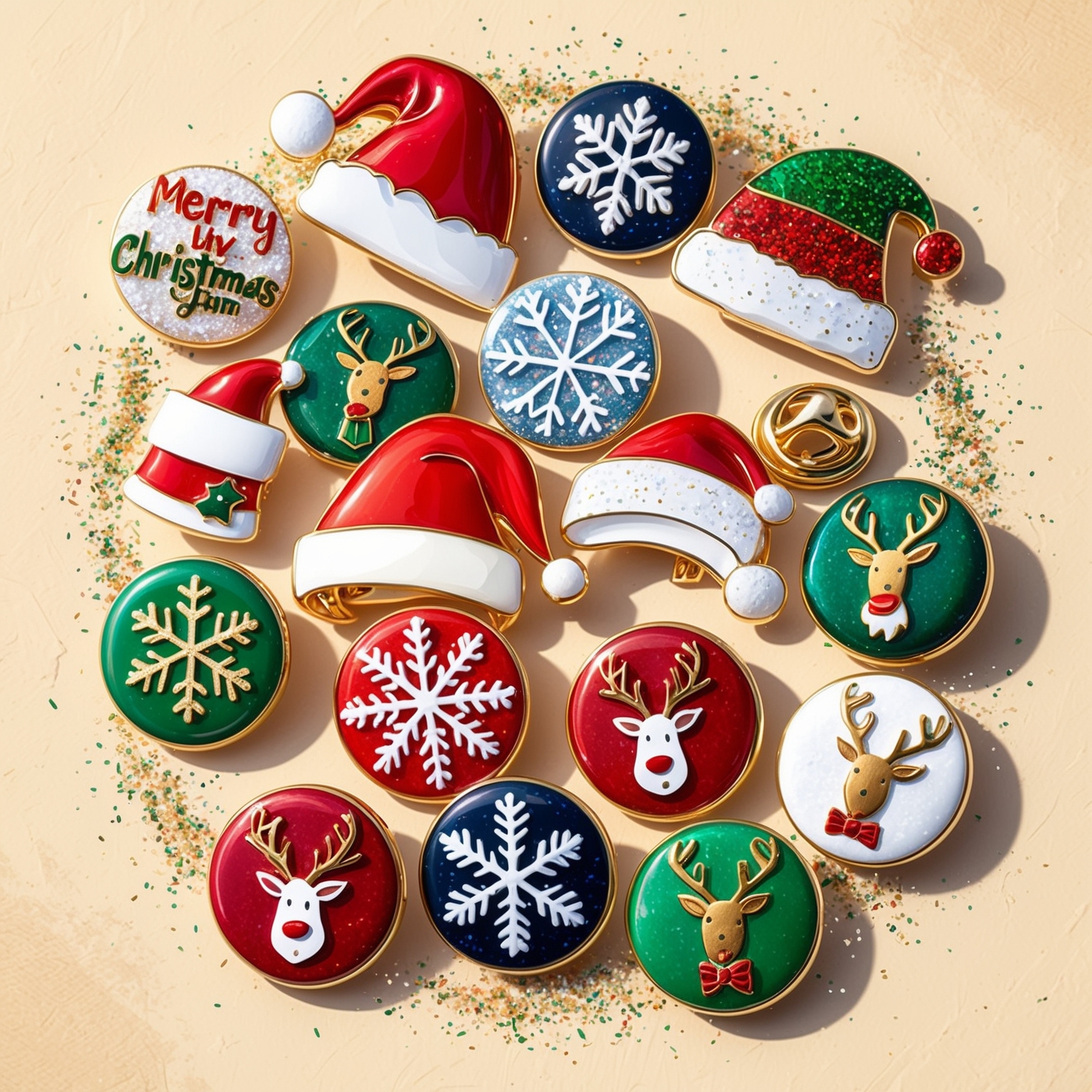Lapel pins have long been a stylish accessory and a symbol of personal expression, representing everything from military honors to corporate branding, political affiliations, and fashion statements. Over the centuries, lapel pins have evolved in design, materials, and significance, reflecting changes in culture, technology, and social norms. This article explores the rich history and evolution of a lapel pin, tracing their journey from classic origins to contemporary forms. By examining the diverse styles and uses of a lapel pin, we gain insight into how these small but significant accessories have captured the public imagination and become an enduring symbol of identity and pride.
Lapel pins are more than just decorative accessories; they are powerful symbols that convey a wide range of messages, from patriotism and affiliation to personal style and achievement. These small pins, typically worn on the lapel of a jacket, have a long and varied history, with origins that date back to ancient civilizations. Over time, a lapel pin has been used to signify rank, commemorate events, promote causes, and enhance fashion.
The evolution of a lapel pin mirrors broader cultural and technological changes. As societies have evolved, so too have the materials, designs, and functions of these pins. From the elaborate brooches of ancient times to the sleek enamel pins of today, a lapel pin have adapted to reflect the values and aesthetics of different eras.
In this article, we will explore the fascinating evolution of a lapel pin, tracing their development from classic origins to contemporary trends. We will examine the historical significance of a lapel pin, their various styles and uses, and how they have been adopted by different cultures and communities. By understanding the history and evolution of lapel pins, we can appreciate their enduring appeal and the diverse ways they continue to be used as a form of self-expression and communication.
1. The Origins and Early History of Lapel Pins
The history of lapel pins can be traced back to ancient civilizations, where they were used as functional and decorative items. The earliest forms of a lapel pin were often brooches or fibulae, which served to fasten clothing and were made from materials such as metal, bone, or wood.
Ancient and Medieval Brooches
In ancient times, brooches were commonly used to fasten cloaks, tunics, and other garments. These early pins were often made from bronze, silver, or gold and featured intricate designs that reflected the wearer’s status and cultural identity. For example, in ancient Rome, fibulae were used not only as functional items but also as symbols of military rank and achievement. The designs of these brooches often included motifs such as animals, geometric patterns, and religious symbols.
During the medieval period, brooches continued to be popular accessories, particularly among the nobility. They were often adorned with gemstones and elaborate engravings, serving as a display of wealth and social status. In addition to their decorative function, brooches were used as tokens of love and loyalty, exchanged as gifts among lovers and allies.
The Renaissance and the Rise of Decorative Pins
The Renaissance era saw a resurgence of interest in classical art and culture, which influenced the design of jewelry and accessories, including a lapel pin. During this period, lapel pins became more decorative, featuring intricate metalwork, enamel, and gemstones. The use of enameling techniques, such as cloisonné and champlevé, allowed for the creation of colorful and detailed designs.
Lapel pins also began to take on symbolic meanings during the Renaissance. They were used to represent membership in guilds, societies, and organizations. For example, members of religious orders often wore pins with symbols representing their faith and dedication. Similarly, a lapel pin were used to denote political affiliations and support for royal houses.
The 18th and 19th Centuries: Lapel Pins as Status Symbols
The 18th and 19th centuries saw a lapel pin become increasingly associated with social status and identity. As Europe experienced the rise of the bourgeoisie, a lapel pin became popular accessories among the emerging middle class. They were often worn as part of formal attire, symbolizing sophistication and refinement.
During this period, a lapel pin also became associated with military and political honors. Medals and insignia were often worn as lapel pins to signify rank, bravery, and service. For example, military officers would wear pins featuring their regiment’s emblem, while politicians and diplomats might wear pins representing their country’s flag or national symbols.
The Victorian era, in particular, saw the proliferation of mourning jewelry, including a lapel pin. These pins were worn as a way to honor and remember deceased loved ones, often featuring black enamel, pearls, and sentimental inscriptions.
2. The Evolution of Lapel Pins in the 20th Century
The 20th century brought significant changes to the design and use of a lapel pin. As new materials and manufacturing techniques became available, a lapel pin became more accessible and diverse in style. The century also saw the rise of lapel pins as tools for political expression, corporate branding, and fashion.
Early 20th Century: The Age of Enamel Pins
The early 20th century marked the rise of enamel lapel pins, which became popular due to their durability and vibrant colors. Enamel pins were made by filling recessed areas with enamel paint and then baking them to create a hard, glossy surface. This technique allowed for the production of detailed and colorful designs.
Enamel pins were widely used for promotional purposes, with companies creating pins featuring their logos and slogans. These pins were often given away as promotional items or used as employee badges. Political parties also used enamel pins to promote their candidates and platforms, with pins featuring campaign slogans and party symbols.
Mid-20th Century: Lapel Pins in Wartime and Politics
The mid-20th century, particularly during World War II, saw lapel pins become a popular way to show support for the war effort. Pins featuring patriotic symbols, such as flags and eagles, were worn by civilians and military personnel alike. These pins served as a way to boost morale and express solidarity.
During the Cold War era, lapel pins were used as symbols of political ideology and loyalty. Both the United States and the Soviet Union produced pins featuring their respective national symbols and propaganda messages. In addition to political uses, lapel pins were also used to commemorate significant events, such as space missions and international exhibitions.
Late 20th Century: The Rise of Corporate and Fashion Pins
The late 20th century saw the commercialization of lapel pins, with companies using them as a form of branding and marketing. Corporate lapel pins became common in the business world, with employees wearing pins featuring their company’s logo as part of their uniform. These pins often served as symbols of company pride and loyalty.
At the same time, lapel pins began to emerge as fashion accessories. Designers and fashion brands created pins with trendy and artistic designs, which were worn as statement pieces. The punk and pop culture movements of the 1970s and 1980s, in particular, embraced lapel pins as a way to express individuality and rebellion. Pins featuring band logos, political slogans, and quirky designs became popular among young people.
3. Contemporary Trends and Uses of Lapel Pins
In the 21st century, lapel pins have continued to evolve, with new trends and uses emerging. The advent of digital design and manufacturing technologies has expanded the possibilities for pin design, making it easier than ever to create custom and unique pins.
Custom and Personalized Lapel Pins
One of the most significant trends in contemporary lapel pins is the rise of custom and personalized designs. Advances in digital design software and manufacturing processes, such as laser cutting and 3D printing, have made it possible for individuals and small businesses to create custom pins with ease.
Custom lapel pins are used for a wide range of purposes, from personal expression and gift-giving to branding and promotional events. They can feature anything from a person’s name or initials to custom artwork or logos. This trend has made lapel pins more accessible and affordable, allowing people to create pins that reflect their unique style and interests.
Lapel Pins as Fashion Accessories
Lapel pins have firmly established themselves as fashion accessories in the contemporary era. Designers and fashion brands continue to experiment with pin designs, incorporating them into seasonal collections and runway shows. Fashion pins often feature minimalist and geometric designs, as well as whimsical and playful motifs.
The versatility of lapel pins makes them an ideal accessory for a wide range of outfits and styles. They can be worn on jackets, coats, hats, bags, and even shoes. The trend of layering multiple pins, known as “pinning,” has become popular, allowing individuals to create a personalized and eclectic look.
Lapel Pins for Social and Political Causes
Lapel pins have long been used as symbols of social and political causes, and this trend continues in the contemporary era. Pins featuring symbols of various movements, such as LGBTQ+ pride, environmental conservation, and social justice, are worn to raise awareness and show support for these causes.
Political campaigns and advocacy groups continue to use lapel pins as a way to promote their messages and rally supporters. These pins often feature slogans, logos, and symbols associated with the cause. In addition to physical pins, digital pins and virtual badges have emerged as new ways to show support online.
Collectible and Limited-Edition Lapel Pins
The collectible aspect of lapel pins has also gained traction in recent years. Limited-edition pins, often released by artists, brands, or events, are highly sought after by collectors. These pins may be produced in small quantities, making them rare and valuable.
Collectors often seek out pins from specific categories, such as Disney pins, sports pins, or artist collaborations. Online communities and trading platforms have emerged, allowing collectors to buy, sell, and trade pins. The thrill of hunting for rare and exclusive pins has made collecting lapel pins a popular hobby.
Lapel Pins in Corporate and Professional Settings
Lapel pins continue to play a role in corporate and professional settings, serving as symbols of affiliation, recognition, and achievement. Many companies and organizations use lapel pins as a way to recognize employees for their service, milestones, or contributions. These pins often feature the company’s logo or emblem and are presented during ceremonies or events.
In addition to corporate settings, lapel pins are commonly used in professional and academic organizations. They may be worn by members of professional associations, alumni groups, or honor societies. These pins serve as a badge of membership and a symbol of pride in one’s professional or academic achievements.
4. The Future of Lapel Pins
As we look to the future, the appeal of lapel pins shows no signs of waning. The versatility, accessibility, and symbolism of lapel pins make them a timeless accessory that can adapt to changing trends and technologies.
Innovations in Design and Manufacturing
Advancements in technology will continue to shape the design and production of lapel pins. New materials, such as sustainable and eco-friendly options, may become more prevalent, reflecting growing environmental consciousness. Innovations in digital design tools and manufacturing techniques, such as 3D printing and laser engraving, will allow for even more intricate and customizable designs.
The use of augmented reality (AR) and virtual reality (VR) could also impact the way lapel pins are experienced and shared. For example, AR pins could feature interactive elements that can be viewed through a smartphone app, adding a new layer of engagement and storytelling.
The Continued Role of Lapel Pins in Expression and Identity
Lapel pins will likely continue to be a popular form of self-expression and identity. As social and political issues evolve, pins will remain a way for individuals to show their support for causes and movements. The rise of digital activism may also lead to new forms of virtual pins and badges that can be shared online.
In fashion, lapel pins will continue to be a versatile accessory that can complement a wide range of styles. The trend of customization and personalization will likely grow, with more people creating and wearing pins that reflect their unique tastes and interests.
The Collectible and Artistic Value of Lapel Pins
The collectible and artistic value of lapel pins is expected to remain strong. As more artists and designers create limited-edition pins, the market for collectible pins will continue to expand. Collectors will seek out rare and unique pins, driven by the thrill of discovery and the desire to own a piece of wearable art.
Exhibitions and galleries dedicated to lapel pins may become more common, highlighting the artistic and cultural significance of these small but impactful objects. The history and evolution of lapel pins could also become a subject of academic study and research, further cementing their place in art and cultural history.
Conclusion
The evolution of lapel pins from classic brooches to contemporary fashion and collectible items is a fascinating journey that reflects broader cultural, technological, and social changes. From their origins as functional fasteners and status symbols to their modern role as tools of self-expression and political activism, lapel pins have maintained their appeal and relevance.
Today, lapel pins are more diverse and accessible than ever, with a wide range of themes, styles, and uses. They continue to be a popular accessory for fashion, a symbol of affiliation and achievement, and a medium for artistic expression. The rise of custom and personalized pins has also made it possible for individuals to create unique designs that reflect their personal identity and interests.
As we move into the future, lapel pins will undoubtedly continue to evolve, influenced by new technologies, materials, and cultural trends. Whether worn as a fashion statement, a badge of honor, or a collectible piece of art, lapel pins remain a powerful and enduring symbol of individuality and pride.
If you are interested in ordering some high-quality lapel pins, feel free to call us at our Toll free number 1-877-513-4811 or fill out one of our FREE QUOTE FORMS.



